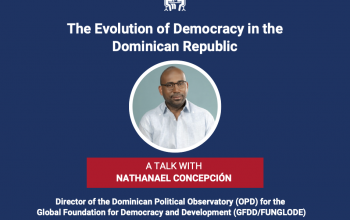news
“The plague of the economic virus”, an article by Dr. Leonel Fernández
March 20, 2021
The economic impact of the coronavirus has been devastating for the Dominican Republic. Last year, the country’s GDP suffered a contraction of -6.7 percent, the largest drop since the April Revolution of 1965 some 55 years ago.
This drop meant that the nominal GDP in dollars, as was recently published by the Dominican Central Bank, plummeted from US$89 billion to US$79 billion, a significant reduction of US$10 billion.
As we have learned, the most impacted sectors during this crisis have been tourism-related establishments such as hotels, bars and restaurants. In total, the data reveals a collapse of -47 percent in economic activity. The construction sector suffered a -16.7 percent drop; mines and quarries, -13.6 percent; services, -11.9; transportation and storage facilities, -9.5 percent; free zones, -6.6 percent; trade, -4.2 percent. Local manufacturing registered a -3.7 percent drop.
However, we should recognize from the data accumulated that since October of last year some of these sectors – such as construction, free zones and local manufacturing – have begun a gradual reactivation process.
Notwithstanding, along with the drop in the country’s GDP, a serious situation has been created due to the drop in revenues. This, in turn, has provoked a fiscal deficit equivalent to 7.4 percent of the GDP.
This is a particularly worrisome situation since even before the pandemic the Dominican Republic had the worst combination of revenue pressure and spending in all of Latin America.
Suffering the pressure created by 13.7 percent of the GDP, well below the Latin American average of 21 percent, the country dropped to just 11.7 percent in 2020.
But the misfortunes provoked by the Covid-19 pandemic did not stop there. It also impacted changes in the local exchange rate and, consequently, influenced the devaluation of the Dominican peso. At the same time, inflation and local prices jumped by approximately 5.6 percent, the highest since 2013. Overall spending grew, as did the country’s public debt.
To summarize, the pandemic has provoked havoc in all sectors generating setbacks, confusion and uncertainty in a country that even though it has faced its ups and downs, it worked to accelerate a process of change and transformation over the last 25 years.
Social Impact
According to data provided by the Economic Commission on Latin America and the Caribbean (ECLAC) in 2020 – and as a consequence of the pandemic – poverty in the Dominican Republic jumped from 20.3 to 21.8 percent. Income and consumption decreased. Social inequality increased. Job occupancy rates fell by 8.8 percent.
The latter represented, in the third quarter of 2020, the disappearance of more than 866,000 jobs. These numbers are truly unnerving and unprecedented in our national history.
Of course, all of this occurred as a result of the temporary suspension of non-essential activities, as well as social distancing and confinement measures that had to be implemented in order to stop the spread of the virus.
Data reveals that micro-businesses suffered the greatest job losses. Approximately 80 percent of these small businesses operate within the informal sector. But, similarly, many of the formal sector companies were also impacted, thus affecting a large part of the business community.
Faced with the economic and social collapse generated by the pandemic, the Dominican government intervened by introducing monetary and fiscal policies. The goal was to generate social protection programs that would mitigate the impact of the pandemic on the most vulnerable sectors of the population.
The Phase I and Phase II social programs were introduced during the pandemic to transfer funds to unemployed workers and to those who continued to work in companies that continued to operate.
In addition, there were the “Pa`Ti” (For You) programs, favoring independent workers. Also, the “Quédate en Casa” (Stay at Home) program, introduced to protect the poor and vulnerable households.
The overall cost of these programs cost the government more than RD$125 billion (approximately US$3 billion).
During the pandemic, monetary policy focused on reducing interest rates, liberalizing the legal reserve in order to guarantee liquidity in the financial sector, and facilitating resources to intervene in foreign exchange markets.
The Year of the Plague
If in 2021 the traditional fiscal fragility of the Dominican economy was impacted, plus an additional situation of lower revenues and higher public spending was added to the overall situation, it would seem reasonable to ask the following question: How will the Dominican economy continue to operate in these times of pandemic?
In principle, it is difficult to imagine because from the onset more than RD$291 billion (almost US$5 billion) are needed to finance the national budget, which is already in deficit.
To do so, new bond issues would have to be made in the capital markets and new agreements reached with multilateral organizations such as the International Monetary Fund and the World Bank.
In terms of domestic debt, financing will only be made possible by the placement of bonds in the local market for more than RD$91 billion pesos (almost US$2 billion).
Naturally, these financial maneuvers will increase the current debt even more, which already stands at about 70 percent of the GDP. Half of all tax revenues will have to be channeled to pay interest rates and amortization.
In this regard, Fitch, the risk rating agency, recently expressed its utmost concern by stating that “Dominican debt went from a stable to a negative outlook.”
What seems to emerge from analyzing the National Budget for 2021 is that in order to procure resources and carry out the works that have been promised, the government would necessarily have to take a series of measures that are delicate and risky.
The first could be the reduction of social services, foreseen by the decrease in public spending for the current year of more than RD$137 billion (close to US$3 billion). That, of course, would provoke discontent and social unrest among the population.
The second is not adjusting wages and pensions in order to face inflation. This would surely impact the foundation of the social pyramid; that is, the most vulnerable.
The third would be an increase in income – estimated at approximately RD$135 billion pesos (almost US$4 billion) – which would be obtained based on the sale of assets of the Dominican Electricity Corporation (CDEEE) and the “Fondo Patrimonial de las Empresas Reformadas” (FONPER-Patrimonial Funds For Reformed Companies) for about RD$76 billion (some US$1.5 billion).
This has yet to be clarified, as it would imply a massive alienation of public assets.
The fourth would be a two-year tax-payment advance agreement with the mining company Barrick Gold, for an amount of more than RD$8 billion (some US$138 million).
There are still RD$51 billion (close to US$1 billion) in anticipated income that, due to a lack of information from the Ministry of Economy and Planning, no one knows where the source of this income will come from.
The economic virus of the pandemic requires a vaccine that, above all, will preserve social protection programs. For Dominican society in general this remedy would play the same role as a ventilator in intensive care units.
An interesting note: Daniel Defoe, the prominent English novelist, wrote Diary of the Year of the Plague where he recounts the calamity that impacted the city of London in the second half of the seventeenth century.
Let us avoid financing modalities that have their roots in an already deficient budget in order to avoid an economic situation in 2021 that could unleash a social plague in the Dominican Republic.






